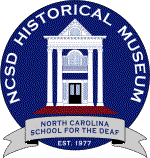Deaf Museums
In the mid/late 1980's Superintendent Sheldon Melton asked Mary Lawson, Fred Yates, Ralph Kiser, Thomas Sebrell, and Dawayne Werner to organize and establish a museum for VSDB. The superintendent secured two rooms on the second floor of Main Hall for the museum.
The committee began to collect documents, effects, and property to display, beginning with an old dollhouse, built in 1907 by the students in the woodworking class, items compiled by Mr. and Mrs. Bass, and many large old pictures of significant people connected with VSDB.
The VSDB museum was relocated to the ground floor of Main Hall in 2002. The museum also houses the VSDB Hall of Fame and Museum Library in a separate room.
The museum is free and open to the public. Visitors need to first contact the VSDB superintendent prior to visiting.
Museum OSD houses a comprehensive collection of items of historical significance and maintains archival records of its film, photographs, and publications. Free tours and research sessions are scheduled through the Outreach Program.
The Deaf Cultural Center’s mission is to provide educational and resourceful programs and activities to inspire a deeper appreciation and understanding of the lives of diverse deaf people, including their language, culture, experiences, achievements and contributions worldwide.
Located on the campus of the Maryland School for the Deaf, the Bjorlee Museum is one of Frederick's newest exhibits. The school opened its doors with 34 students in Sept of 1868 and was housed in two Revolutionary War era stone barracks. The remaining Hessian Barracks is adjacent to the museum. The collection began in 1872 houses school related artifacts, as well as many items of local interest reflecting aspects of Frederick City's long history. Open daily 8:30am-3:30pm. Appointments suggested.
Our organization objective is to collect all available historical material connected with the history of the North Carolina for the Deaf at Morganton, North Carolina and to preserve the same and record in in such an ordely manner that it may be more readily utilized for edcational purposes.




